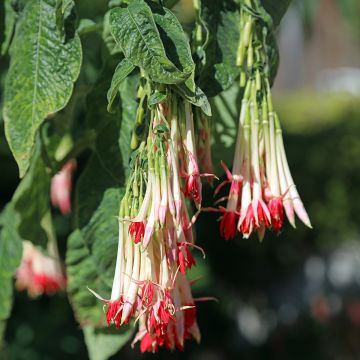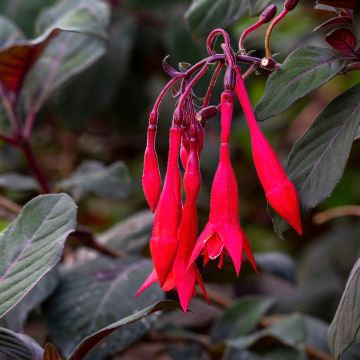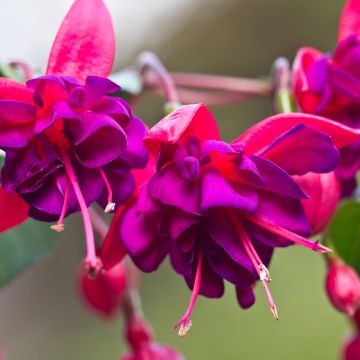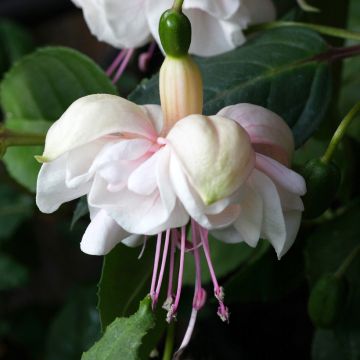

Fuchsia procumbens


Fuchsia procumbens
Fuchsia procumbens
Fuchsia procumbens
Trailing fuchsia, Basket fuchsia, Trailing queen
Special offer!
Receive a €20 voucher for any order over €90 (excluding delivery costs, credit notes, and plastic-free options)!
1- Add your favorite plants to your cart.
2- Once you have reached €90, confirm your order (you can even choose the delivery date!).
3- As soon as your order is shipped, you will receive an email containing your voucher code, valid for 3 months (90 days).
Your voucher is unique and can only be used once, for any order with a minimum value of €20, excluding delivery costs.
Can be combined with other current offers, non-divisible and non-refundable.
Why not try an alternative variety in stock?
View all →This plant carries a 6 months recovery warranty
More information
We guarantee the quality of our plants for a full growing cycle, and will replace at our expense any plant that fails to recover under normal climatic and planting conditions.
Would this plant suit my garden?
Set up your Plantfit profile →
Description
Fuchsia procumbens is a creeping perennial species. It forms a ground cover with small rounded leaves and astonishing corolla-less flowers that reveal yellow, purple, and blue shades. The flowers bloom in summer before giving way to purple, plum-like fruits, which are enjoyed in jam in their country of origin. This attractive plant is not very hardy, but it can be grown in a pot and brought indoors during winter. In mild regions, it can be planted in the ground, in partial shade, in fertile, well-drained, and moist soil.
Fuchsia procumbens belongs to the Onagraceae family. It is native to New Zealand, where it grows on the northern coastal part of the country. It has a creeping habit, reaching a height of 15cm (6in) and spreading about 40cm (16in). The small, round, green leaves are semi-evergreen. The flower is equally unusual for a fuchsia. The upright, tubular flowers, 1.5cm (1in) long, have a yellow calyx, curved sepals, pink stamens, and blue pollen, creating a small multicoloured marvel to be observed up close. It blooms in summer, from July-August to September.
This fuchsia is a tender perennial that can be grown outdoors in mild climates, where the temperature does not drop below -5°C (23°F). Otherwise, grow it in a pot and bring it indoors for winter. Choose a sheltered location, in partial shade or non-burning sun, in moist, preferably rich and well-drained soil or substrate. The foliage resembles muehlenbeckia. It looks beautiful in hanging baskets or in a container placed where its miniature flowers can be observed, which are sometimes hidden under the foliage. Leave it alone in its pot, but possibly place it among plants with similar needs.
Discovered in Santo Domingo in the 17th century and acclimatised in Europe, it was named Fuchsia (not Fuschia) in honour of a German botanist named Fuchs. Native to South America, botanical fuchsias have gradually multiplied. There are now believed to be tens of thousands of hybrids!
Fuchsia procumbens in pictures




Flowering
Foliage
Plant habit
Botanical data
Fuchsia
procumbens
Onagraceae
Trailing fuchsia, Basket fuchsia, Trailing queen
Oceania
Other Fuchsia
View all →Planting and care
Plant Fuchsia procumbens in fairly rich, moist and well-drained substrate, in full sun or partial shade. Choose a geranium-type potting soil. Fuchsias need plenty of light to flower well, but they are sensitive to full sun in summer. Water regularly, as they are susceptible to drought. However, do not water to excess. When grown in pots, do not leave water in the saucer, as this would cause the roots to rot and the leaves to fall. Use a fine mulch such as buckwheat husks to maintain the substrate's moisture. Apply a liquid fertiliser every 15 days during the growth period.
Planting period
Intended location
Care
Planting & care advice
This item has not been reviewed yet - be the first to leave a review about it.
Similar products
Haven't found what you were looking for?
Hardiness is the lowest winter temperature a plant can endure without suffering serious damage or even dying. However, hardiness is affected by location (a sheltered area, such as a patio), protection (winter cover) and soil type (hardiness is improved by well-drained soil).

Photo Sharing Terms & Conditions
In order to encourage gardeners to interact and share their experiences, Promesse de fleurs offers various media enabling content to be uploaded onto its Site - in particular via the ‘Photo sharing’ module.
The User agrees to refrain from:
- Posting any content that is illegal, prejudicial, insulting, racist, inciteful to hatred, revisionist, contrary to public decency, that infringes on privacy or on the privacy rights of third parties, in particular the publicity rights of persons and goods, intellectual property rights, or the right to privacy.
- Submitting content on behalf of a third party;
- Impersonate the identity of a third party and/or publish any personal information about a third party;
In general, the User undertakes to refrain from any unethical behaviour.
All Content (in particular text, comments, files, images, photos, videos, creative works, etc.), which may be subject to property or intellectual property rights, image or other private rights, shall remain the property of the User, subject to the limited rights granted by the terms of the licence granted by Promesse de fleurs as stated below. Users are at liberty to publish or not to publish such Content on the Site, notably via the ‘Photo Sharing’ facility, and accept that this Content shall be made public and freely accessible, notably on the Internet.
Users further acknowledge, undertake to have ,and guarantee that they hold all necessary rights and permissions to publish such material on the Site, in particular with regard to the legislation in force pertaining to any privacy, property, intellectual property, image, or contractual rights, or rights of any other nature. By publishing such Content on the Site, Users acknowledge accepting full liability as publishers of the Content within the meaning of the law, and grant Promesse de fleurs, free of charge, an inclusive, worldwide licence for the said Content for the entire duration of its publication, including all reproduction, representation, up/downloading, displaying, performing, transmission, and storage rights.
Users also grant permission for their name to be linked to the Content and accept that this link may not always be made available.
By engaging in posting material, Users consent to their Content becoming automatically accessible on the Internet, in particular on other sites and/or blogs and/or web pages of the Promesse de fleurs site, including in particular social pages and the Promesse de fleurs catalogue.
Users may secure the removal of entrusted content free of charge by issuing a simple request via our contact form.
The flowering period indicated on our website applies to countries and regions located in USDA zone 8 (France, the United Kingdom, Ireland, the Netherlands, etc.)
It will vary according to where you live:
- In zones 9 to 10 (Italy, Spain, Greece, etc.), flowering will occur about 2 to 4 weeks earlier.
- In zones 6 to 7 (Germany, Poland, Slovenia, and lower mountainous regions), flowering will be delayed by 2 to 3 weeks.
- In zone 5 (Central Europe, Scandinavia), blooming will be delayed by 3 to 5 weeks.
In temperate climates, pruning of spring-flowering shrubs (forsythia, spireas, etc.) should be done just after flowering.
Pruning of summer-flowering shrubs (Indian Lilac, Perovskia, etc.) can be done in winter or spring.
In cold regions as well as with frost-sensitive plants, avoid pruning too early when severe frosts may still occur.
The planting period indicated on our website applies to countries and regions located in USDA zone 8 (France, United Kingdom, Ireland, Netherlands).
It will vary according to where you live:
- In Mediterranean zones (Marseille, Madrid, Milan, etc.), autumn and winter are the best planting periods.
- In continental zones (Strasbourg, Munich, Vienna, etc.), delay planting by 2 to 3 weeks in spring and bring it forward by 2 to 4 weeks in autumn.
- In mountainous regions (the Alps, Pyrenees, Carpathians, etc.), it is best to plant in late spring (May-June) or late summer (August-September).
The harvesting period indicated on our website applies to countries and regions in USDA zone 8 (France, England, Ireland, the Netherlands).
In colder areas (Scandinavia, Poland, Austria...) fruit and vegetable harvests are likely to be delayed by 3-4 weeks.
In warmer areas (Italy, Spain, Greece, etc.), harvesting will probably take place earlier, depending on weather conditions.
The sowing periods indicated on our website apply to countries and regions within USDA Zone 8 (France, UK, Ireland, Netherlands).
In colder areas (Scandinavia, Poland, Austria...), delay any outdoor sowing by 3-4 weeks, or sow under glass.
In warmer climes (Italy, Spain, Greece, etc.), bring outdoor sowing forward by a few weeks.



































































